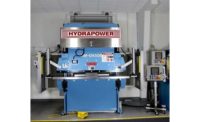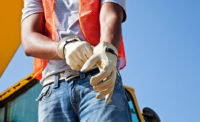Data from the Bureau of Labor Statistics (BLS) indicate that about 20,000 amputations occur each year. Between 1,600 and 2,000 (10%) of these amputations have occurred among mechanical power press operators.
Recent statistics compiled by OSHA indicate that approximately 49% of the injuries on mechanical power presses result in an amputation. NIOSH research (based on injury frequency and severity data, operator hand speeds, compensation paid, and extent of worker exposure) indicate that young male operators appear to be at greater risk than other operators and mechanical power presses are the metalworking machines most in need of research to improve safety.
NIOSH has published a Current Intelligence Bulletin (CIB) with recommendations for the safe use of mechanical power presses, specifically those operated by foot or dual palm-button controls. Adherence to these recommendations should reduce the risk of injury among mechanical power press operators.
Background
Some amputations involving power presses occur when the operator places a hand into the working zone (or point of operation) of the press after the press operation is initiated. Most prevention activities involve the placement of guards to prevent operators from placing their hands into the working zone of the press. Guarding an industrial machine is an important safety action that should not be neglected. However, because the shape of the part to be stamped may require reaching near the hazard point, or because guarding alone is not always adequate, employers and manufacturers of presses should also examine how the press is controlled as a way of preventing amputations.
Conclusions
Even though there is an existing OSHA standard that addresses construction and operation of mechanical power presses, injuries and amputations among press operators are still occurring with alarming frequency. In many cases, these injuries occur when the press is inadvertently activated while the operator's hands are in the operating zone of the press.
The results of an experiment conducted by NIOSH researchers indicate that the chance for inadvertent press activation (possibly involving injury) may increase as the cycling rate.
Injuries occur as a result of "after-reach" among operators who initiate power presses using dual palm buttons. Attention should be given to the individual operator's hand speed, keeping in mind that, in general hand speed may be a function of age and gender.
Injuries may also occur as a result of deactivating or overriding safeguards. Under no circumstances should safeguards be deactivated or overridden.
Recommendations
The recommendations presented here were compiled from generally accepted safety practices and research; they are intended to supplement existing OSHA standards. Implementation of these recommendations should be considered in any comprehensive safety program for the prevention of injuries among mechanical power press operators. These data from NIOSH studies demonstrate that hand speed may be an inappropriate measure on which to base a safety distance standard for operation of mechanical power presses.
It may be impractical to implement a single hand-speed constant which would protect all workers under all power press set-ups. Implementation of such a hand-speed standard would render dual palm buttons practically useless as a safeguarding device due to the long safety distances which would result.
Foot-Controlled Power Presses
- Foot controls should be used with point-of-operation safeguards that cannot be easily bypassed or misadjusted.
- Interlocking safeguards should be considered so that the foot control is inoperable when the safeguards are not functioning.
- An ergonomically correct, sitting work position, if possible, is preferred over a standing position if a foot control is used.
- To reduce strain on the foot, a foot-rest should be provided near the pedal.
- Riding the pedal (keeping the foot on the pedal without actually depressing it) is hazardous, and standard operating procedures should note this unacceptable work practice.
- The rate at which presses are being cycled should be monitored periodically to ensure that operators are not working at a pace that leads to inadvertent pressing of the foot pedal.
Power Presses Controlled with Dual Palm Buttons
- Because full-revolution clutches cannot be stopped once they are activated, they should only be used on presses with short downstrokes or fast cycling rates.
- To reduce musculoskeletal stress to the wrists, arms, and shoulders of press operators, ergonomic job design principles should be considered when locating and/or orienting dual palm buttons in relation to the point of operation.
- Caution must be exercised in evaluating each power press set-up and operation to ensure that an adequate safety distance is maintained at all times. Employers should consider evaluating individual press operators to determine if they are exceeding the current OSHA hand-speed constant. If a worker is identified as being capable of exceeding the hand-speed constant, more positive means of point-of-operation safeguarding should be considered, such as fixed barrier guards.
Recommended Checklists for Safe Operation of Mechanical Power Presses
The checklists presented below are provided as an adjunct to the above recommendations to aid in maintaining safe use of foot and dual palm-button controls for mechanical power presses.
Checklist to be used when foot controls are used:
- Safeguards are in place which will prevent injury if the foot control is inadvertently depressed.
- A guard or cover is over the foot switch to prevent activation by fallen objects.
- The working posture is as nonfatiguing as possible. Seating is provided where possible.
- Presence-sensing devices, if used, are properly maintained and aligned to ensure that the sensing field is effectively safeguarding the point of operation.
- Work rules have been established against riding the foot pedal.
- A check has been made to see if operators inadvertently push the foot switch because they are working at a high cycling rate with the foot control.
- The brake monitor, if required, is operative.
- The foot control must be depressed and released once before the press can be cycled again.
- Safeguarding devices and procedures are available for die set-up and maintenance to prevent or arrest an inadvertent downstroke of the ram.
- The press is routinely and frequently inspected and properly maintained.
Checklist to be used when dual palm buttons are used:
- The palm buttons are installed to meet at least the OSHA minimum safety distance requirements. Greater distances are recommended based on the operator's true hand speed.
- The palm buttons are installed to reduce undue operator fatigue.
- The palm buttons are protected against unintended operation and are arranged so that the only probable means of operation is by both hands of a single worker, or by both hands of each operator where more than one operator is being protected by dual palm buttons.
- On presses with part-revolution clutches, the removal of a worker's hand from any palm button during the downstroke of the ram quickly deactivates the clutch and applies the brake to stop ram motion.
- The brake monitor, if required, is operative.
- All palm buttons must be released before an interrupted stroke can be resumed or the press can be cycled again.
- The palm but tons are fixed in a position so that only a set-up person, supervisor, or safety engineer can move them.
- The position of the palm buttons is arranged to prevent any part of the body from entering the working zone of the press during the downstroke.
- The operation of the press is monitored frequently to ensure that operators are not bypassing or defeating the safety features of the dual palm buttons.
- Safeguarding devices and procedures are available for die set-up and maintenance to prevent or arrest an inadvertent downstroke of the ram.
- Presence-sensing devices, if used, are properly maintained and aligned to ensure that the sensing field is effectively safeguarding the point of operation.
- The press is routinely and frequently inspected and properly maintained.
Source: NIOSH



